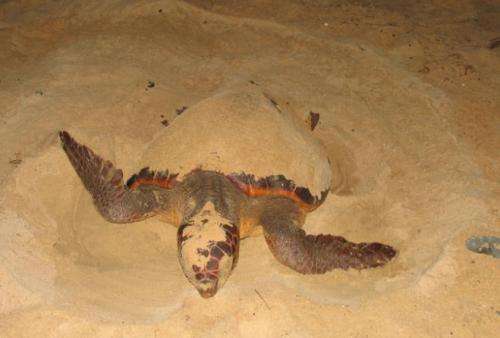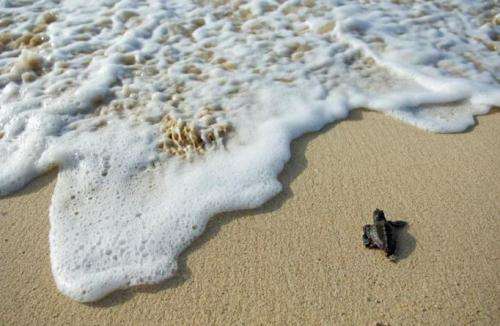Study of mitochondrial DNA reveals how the loggerhead turtle reached the Mediterranean

To date, it was thought that the loggerhead turtle arrived to the Mediterranean from North America and the Caribbean after the last glacial period. However, latest scientific studies show that this marine species colonized the Mediterranean between 20,000 and 200,000 years ago, so the colonization event took place before the last glacial period. Experts Lluís Cardona, Àlex Aguilar and Marcel Clusa from the Department of Animal Biology and the Biodiversity Research Institute (IRBio) of the University of Barcelona (UB), and Carlos Carreras and Marta Pascual (member of IRBio), from the Department of Genetics of UB, participated in these studies.
Loggerhead turtle (Caretta caretta) is the most common turtle inhabiting Mediterranean grounds and one of the most threatened species around the world. Its main nesting sites are located in North-American coast, Brazil, Japan, Oman, Australia, Cape Verde and Eastern Mediterranean (specially, Greece, Turkey, Cyprus and Libya). In Spanish waters there are turtles of Atlantic and Eastern Mediterranean origin.
Loggerhead turtle: the route towards the Mediterranean
Around five million years ago, the loggerhead turtle was globally distributed in the Atlantic and the Pacific, until the rise of the Isthmus of Panama split the population into two groups (one in each ocean). According to Lluís Cardona, "nowadays, species' largest nesting aggregations in the Atlantic are in Brazil, Cape Verde, North America and the Caribbean, but its historical relations with the Mediterranean basin remained quite unknown".
"Contrary to what it was thought, the colonization process of the Mediterranean —highlights Cardona— took place before the last glacial period. This indicates that loggerhead turtles have survived, at least, to one glacial period in the Mediterranean; they sought refuge at warmer sites, on Libya, Turkey and Greece coasts".
To be exact, the loggerhead turtle colonised the Mediterranean at least in two independent colonisation events. The first one (around 50,000 – 200,000 years ago) colonised the Eastern Mediterranean, and in the second, much more recent (after the last glacial period), the species colonised Southern Italy, particularly Calabria. "Results are surprising: they indicate that the ability to expand of the loggerhead turtle is notable", points out Cardona.

In the Atlantic, a second colonization event with Indo-Pacific origin took place too. The distribution of oceanic currents and water temperature indicate that the process would have followed a zigzag pattern from South Africa to Brazil, Cape Verde and the Caribbean and Eastern North America. For example, in Brazil, the origin of loggerhead turtles is this second colonization event; however, in the Cape Verde Islands, the Caribbean and North America, there are turtles of these two lineages.
When turtles do not come back to natal beaches
Despite extensive migrations, the loggerhead turtle returns to nest in the region where it hatched (natal philopatry). Nevertheless, new studies prove that not all females come back to nest in the region where they hatched. Studies also indicate that the colonization of new regions is a recent process. "Philopatry is not as perfect as it was first thought: there are some individuals that do not come back to natal nesting sites, so they colonise new regions. This provides us with information about the mechanisms to colonize new sites that respond to environmental changes", says Cardona.
The new map about the distribution of loggerhead turtles in Atlantic and Mediterranean waters has been elaborated by applying high resolution techniques to study mitochondrial DNA sequences and thanks to the joint work developed by international research teams that study different geographic distribution sites. By creating databases about nesting sites, experts can know the origin of turtles that inhabit different foraging grounds.
"Concerning conservation, studies provide key information to assess better the impact of human activities on certain populations, for instance the impact of bycatch and longline fishing. For example, we know that longline fishing in the Western Mediterranean affects particularly turtles from America and Mediterranean turtles hatched in Libya coast", concludes Lluís Cardona.
More information: Brian M. Shamblin, Alan B. Bolten, F. Alberto Abreu Grobois, Karen A. Bjorndal, Lluís Cardona, Carlos Carreras, Marcel Clusa, Catalina Monzón Argüello, Campbell J. Nairn, Janne T. Nielsen, Ronel Nel, Luciano S. Soares, Kelly R. Stewart, Sibelle T. Vilaça, Oguz Türkozan, Can Yilmaz, Peter H. Dutton."Geographic Patterns of Genetic Variation in a Broadly Distributed Marine Vertebrate: New Insights into Loggerhead Turtle Stock Structure from Expanded Mitochondrial DNA Sequences". PLOS ONE, enero de 2014. DOI: 10.1371/journal.pone.0085956
Marcel Clusa, Carlos Carreras, Marta Pascual, Stephen J. Gaughran, Susanna Piovano, Cristina Giacoma, Gloria Fernández, Yaniv Levy, Jesús Tomás, Juan Antonio Raga, Fulvio Maffucci, Sandra Hochscheid, Àlex Aguilar, Lluís Cardona. "Fine-scale distribution of juvenile Atlantic and Mediterranean loggerhead turtles (Caretta caretta) in the Mediterranean Sea". Marine Biology, marzo de 2014. DOI: 10.1007/s00227-013-2353-y
Marcel Clusa, Carlos Carreras, Marta Pascual, Andreas Demetropoulos, Dimitris Margaritoulis, Alan F. Rees, Abdulmaula A. Hamza, Mona Khalil, Monica Aureggi, Yaniv Levy, Ogüz Türkozan, Adolfo Marco, Alex Aguilar, Luis Cardona. "Mitochondrial DNA reveals Pleistocenic colonisation of the Mediterranean by loggerhead turtles (Caretta caretta)". Journal of Experimental Marine Biology and Ecology, enero de 2013. DOI: 10.1016/j.jembe.2012.10.011
Journal information: PLoS ONE , Marine Biology , Journal of Experimental Marine Biology and Ecology
Provided by University of Barcelona

















